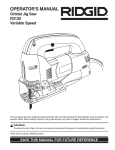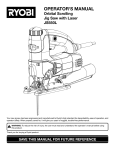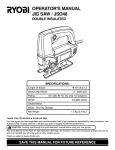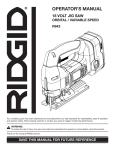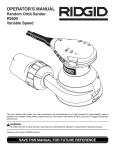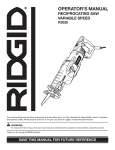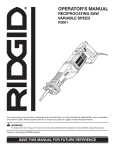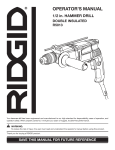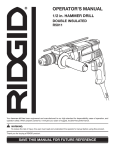Download RIDGID R3121 Operator`s manual
Transcript
OPERATOR’S MANUAL ORBITAL JIG SAW VARIABLE SPEED DOUBLE INSULATED R3121 A B Your jig saw has been engineered and manufactured to our high standard for dependability, ease of operation, and operator safety. When properly cared for, it will give you years of rugged, trouble-free performance. WARNING: To reduce the risk of injury, the user must read and understand the operator’s manual before using this product. Thank you for buying a RIDGID product. SAVE THIS MANUAL FOR FUTURE REFERENCE 1 TABLE OF CONTENTS Introduction ...................................................................................................................................................................... 2 General Safety Rules .....................................................................................................................................................3-4 Specific Safety Rules ........................................................................................................................................................ 4 Symbols .........................................................................................................................................................................5-6 Electrical ........................................................................................................................................................................... 7 Features .........................................................................................................................................................................8-9 Assembly .......................................................................................................................................................................... 9 Operation ...................................................................................................................................................................10-15 Maintenance ................................................................................................................................................................... 16 Warranty ......................................................................................................................................................................... 17 Customer Service Information ........................................................................................................................................ 18 INTRODUCTION This tool has many features for making its use more pleasant and enjoyable. Safety, performance, and dependability have been given top priority in the design of this product making it easy to maintain and operate. 2 GENERAL SAFETY RULES Remove any adjusting key or wrench before turning the power tool on. A wrench or a key left attached to a rotating part of the power tool may result in personal injury. Do not overreach. Keep proper footing and balance at all times. This enables better control of the power tool in unexpected situations. Dress properly. Do not wear loose clothing or jewelry. Keep your hair, clothing and gloves away from moving parts. Loose clothes, jewelry, or long hair can be caught in moving parts. If devices are provided for the connection of dust extraction and collection facilities, ensure these are connected and properly used. Use of these devices can reduce dust-related hazards. Do not wear loose clothing or jewelry. Contain long hair. Loose clothes, jewelry, or long hair can be drawn into air vents. Do not use on a ladder or unstable support. Stable footing on a solid surface enables better control of the power tool in unexpected situations. WARNING: Read all instructions. Failure to follow all instructions listed below may result in electric shock, fire and/or serious injury. The term “power tool” in all of the warnings listed below refers to your mains-operated (corded) power tool or battery-operated (cordless) power tool. SAVE THESE INSTRUCTIONS WORK AREA SAFETY Keep work area clean and well lit. Cluttered or dark areas invite accidents. Do not operate power tools in explosive atmospheres, such as in the presence of flammable liquids, gases or dust. Power tools create sparks which may ignite the dust or fumes. Keep children and bystanders away while operating a power tool. Distractions can cause you to lose control. ELECTRICAL SAFETY POWER TOOL USE AND CARE Power tool plugs must match the outlet. Never modify the plug in any way. Do not use any adapter plugs with earthed (grounded) power tools. Unmodified plugs and matching outlets will reduce risk of electric shock. Avoid body contact with earthed or grounded surfaces such as pipes, radiators, ranges and refrigerators. There is an increased risk of electric shock if your body is earthed or grounded. Do not expose power tools to rain or wet conditions. Water entering a power tool will increase the risk of electric shock. Do not abuse the cord. Never use the cord for carrying, pulling or unplugging the power tool. Keep cord away from heat, oil, sharp edges or moving parts. Damaged or entangled cords increase the risk of electric shock. When operating a power tool outdoors, use an extension cord suitable for outdoor use. Use of a cord suitable for outdoor use reduces the risk of electric shock. Do not force the power tool. Use the correct power tool for your application. The correct power tool will do the job better and safer at the rate for which it was designed. Do not use the power tool if the switch does not turn it on and off. Any power tool that cannot be controlled with the switch is dangerous and must be repaired. Disconnect the plug from the power source and/or the battery pack from the power tool before making any adjustments, changing accessories, or storing power tools. Such preventive safety measures reduce the risk of starting the power tool accidentally. Store idle power tools out of the reach of children and do not allow persons unfamiliar with the power tool or these instructions to operate the power tool. Power tools are dangerous in the hands of untrained users. Maintain power tools. Check for misalignment or binding of moving parts, breakage of parts, and any other condition that may affect the power tool’s operation. If damaged, have the power tool repaired before use. Many accidents are caused by poorly maintained power tools. Keep cutting tools sharp and clean. Properly maintained cutting tools with sharp cutting edges are less likely to bind and are easier to control. Use the power tool, accessories and tool bits etc., in accordance with these instructions and in the manner intended for the particular type of power tool, taking into account the working conditions and the work to be performed. Use of the power tool for operations different from those intended could result in a hazardous situation. PERSONAL SAFETY Stay alert, watch what you are doing and use common sense when operating a power tool. Do not use a power tool while you are tired or under the influence of drugs, alcohol or medication. A moment of inattention while operating power tools may result in serious personal injury. Use safety equipment. Always wear eye protection. Safety equipment such as dust mask, non-skid safety shoes, hard hat, or hearing protection used for appropriate conditions will reduce personal injuries. Avoid accidental starting. Ensure the switch is in the off-position before plugging in. Carrying power tools with your finger on the switch or plugging in power tools that have the switch on invites accidents. 3 GENERAL SAFETY RULES SERVICE When servicing a power tool, use only identical replacement parts. Follow instructions in the Maintenance section of this manual. Use of unauthorized parts or failure to follow Maintenance instructions may create a risk of shock or injury. Have your power tool serviced by a qualified repair person using only identical replacement parts. This will ensure that the safety of the power tool is maintained. WARNING! To reduce the risk of injury, user must read instruction manual. SPECIFIC SAFETY RULES Hold power tools by insulated gripping surfaces when performing an operation where the cutting tool may contact hidden wiring or its own cord. Contact with a “live” wire will make exposed metal parts of the tool “live” and shock the operator. Check damaged parts. Before further use of the tool, a guard or other part that is damaged should be carefully checked to determine that it will operate properly and perform its intended function. Check for alignment of moving parts, binding of moving parts, breakage of parts, mounting, and any other conditions that may affect its operation. A guard or other part that is damaged should be properly repaired or replaced by an authorized service center. Following this rule will reduce the risk of shock, fire, or serious injury. Use clamps or another practical way to secure and support the workpiece to a stable platform. Holding the work by hand or against your body leaves it unstable and may lead to loss of control. Know your power tool. Read operator’s manual carefully. Learn its applications and limitations, as well as the specific potential hazards related to this tool. Following this rule will reduce the risk of electric shock, fire, or serious injury. Make sure your extension cord is in good condition. When using an extension cord, be sure to use one heavy enough to carry the current your product will draw. A wire gauge size (A.W.G.) of at least 14 is recommended for an extension cord 50 feet or less in length. A cord exceeding 100 feet is not recommended. If in doubt, use the next heavier gauge. The smaller the gauge number, the heavier the cord. An undersized cord will cause a drop in line voltage resulting in loss of power and overheating. Always wear safety glasses. Everyday eyeglasses have only impact-resistant lenses; they are NOT safety glasses. Following this rule will reduce the risk of serious personal injury. Protect your lungs. Wear a face or dust mask if the operation is dusty. Following this rule will reduce the risk of serious personal injury. Inspect for and remove all nails from lumber before using this tool. Following this rule will reduce the risk of serious personal injury. Protect your hearing. Wear hearing protection during extended periods of operation. Following this rule will reduce the risk of serious personal injury. Save these instructions. Refer to them frequently and use them to instruct others who may use this tool. If you loan someone this tool, loan them these instructions also. Inspect tool cords periodically and, if damaged, have repaired at your nearest authorized service center. Constantly stay aware of cord location. Following this rule will reduce the risk of electric shock or fire. WARNING: Some dust created by power sanding, sawing, grinding, drilling, and other construction activities contains chemicals known to cause cancer, birth defects or other reproductive harm. Some examples of these chemicals are: • lead from lead-based paints, • crystalline silica from bricks and cement and other masonry products, and • arsenic and chromium from chemically-treated lumber. Your risk from these exposures varies, depending on how often you do this type of work. To reduce your exposure to these chemicals: work in a well ventilated area, and work with approved safety equipment, such as those dust masks that are specially designed to filter out microscopic particles. 4 SYMBOLS Some of the following symbols may be used on this tool. Please study them and learn their meaning. Proper interpretation of these symbols will allow you to operate the tool better and safer. SYMBOL NAME DESIGNATION/EXPLANATION V Volts Voltage A Amperes Current Hz Hertz Frequency (cycles per second) W Watt Power Minutes Time Alternating Current Type of current Direct Current Type or a characteristic of current No Load Speed Rotational speed, at no load Class II Construction Double-insulated construction Per Minute Revolutions, strokes, surface speed, orbits etc., per minute Wet Conditions Alert Do not expose to rain or use in damp locations. Read The Operator’s Manual To reduce the risk of injury, user must read and understand operator’s manual before using this product. Eye Protection Always wear safety goggles, safety glasses with side shields, or a full face shield when operating this product. Safety Alert Precautions that involve your safety. No Hands Symbol Failure to keep your hands away from the blade will result in serious personal injury. No Hands Symbol Failure to keep your hands away from the blade will result in serious personal injury. No Hands Symbol Failure to keep your hands away from the blade will result in serious personal injury. No Hands Symbol Failure to keep your hands away from the blade will result in serious personal injury. Hot Surface To reduce the risk of injury or damage, avoid contact with any hot surface. min no .../min 5 SYMBOLS The following signal words and meanings are intended to explain the levels of risk associated with this product. SYMBOL SIGNAL MEANING DANGER: Indicates an imminently hazardous situation, which, if not avoided, will result in death or serious injury. WARNING: Indicates a potentially hazardous situation, which, if not avoided, could result in death or serious injury. CAUTION: Indicates a potentially hazardous situation, which, if not avoided, may result in minor or moderate injury. CAUTION: (Without Safety Alert Symbol) Indicates a situation that may result in property damage. SERVICE WARNING: To avoid serious personal injury, do not Servicing requires extreme care and knowledge and should be performed only by a qualified service technician. For service we suggest you return the product to the nearest AUTHORIZED SERVICE CENTER for repair. When servicing, use only identical replacement parts. attempt to use this product until you read thoroughly and understand completely the operator’s manual. Save this operator’s manual and review frequently for continuing safe operation and instructing others who may use this product. WARNING: The operation of any power tool can result in foreign objects being thrown into your eyes, which can result in severe eye damage. Before beginning power tool operation, always wear safety goggles, safety glasses with side shields, or a full face shield when needed. We recommend Wide Vision Safety Mask for use over eyeglasses or standard safety glasses with side shields. Always use eye protection which is marked to comply with ANSI Z87.1. SAVE THESE INSTRUCTIONS 6 ELECTRICAL DOUBLE INSULATION EXTENSION CORDS Double insulation is a concept in safety in electric power tools, which eliminates the need for the usual three-wire grounded power cord. All exposed metal parts are isolated from the internal metal motor components with protecting insulation. Double insulated tools do not need to be grounded. When using a power tool at a considerable distance from a power source, be sure to use an extension cord that has the capacity to handle the current the tool will draw. An undersized cord will cause a drop in line voltage, resulting in overheating and loss of power. Use the chart to determine the minimum wire size required in an extension cord. Only round jacketed cords listed by Underwriter’s Laboratories (UL) should be used. WARNING: When working outdoors with a tool, use an extension cord that is designed for outside use. This type of cord is designated with “WA” on the cord’s jacket. The double insulated system is intended to protect the user from shock resulting from a break in the tool’s internal wiring. Observe all normal safety precautions to avoid electrical shock. Before using any extension cord, inspect it for loose or exposed wires and cut or worn insulation. NOTE: Servicing of a tool with double insulation requires extreme care and knowledge of the system and should be performed only by a qualified service technician. For service, we suggest you return the tool to your nearest authorized service center for repair. Always use original factory replacement parts when servicing. **Ampere rating (on tool data plate) 0-2.0 2.1-3.4 Cord Length ELECTRICAL CONNECTION This tool has a precision-built electric motor. It should be connected to a power supply that is 120 volts, 60 Hz, AC only (normal household current). Do not operate this tool on direct current (DC). A substantial voltage drop will cause a loss of power and the motor will overheat. If the tool does not operate when plugged into an outlet, double-check the power supply. 3.5-5.0 5.1-7.0 7.1-12.0 12.1-16.0 Wire Size (A.W.G.) 25' 16 16 16 16 14 14 50' 16 16 16 14 14 12 100' 16 16 14 12 10 — **Used on 12 gauge - 20 amp circuit. NOTE: AWG = American Wire Gauge WARNING: Keep the extension cord clear of the working area. Position the cord so that it will not get caught on lumber, tools or other obstructions while you are working with a power tool. Failure to do so can result in serious personal injury. WARNING: Check extension cords before each use. If damaged replace immediately. Never use tool with a damaged cord since touching the damaged area could cause electrical shock resulting in serious injury. 7 FEATURES PRODUCT SPECIFICATIONS Stroke Length................................................................1 in. No Load Speed ..........................................500-3,000/min. Orbital Settings...................................................................5 Input ................................ 120 V, 60 Hz, AC Only, 6.0 Amp Weight .................................................................... 6.7 lbs. DUST COLLECTION VACUUM ATTACHMENT LOCK-ON BUTTON VARIABLE SPEED CONTROL SELECTOR SWITCH TRIGGER RAPID CHANGE BLADE CLAMP SPLINTER GUARD SAW BLADE ORBITAL ADJUSTMENT KNOB RECESSED BLADE SUPPORT ROLLER BASE NO-MAR BASE PLATE CHIP SHIELD LIGHTED PLUG Fig. 1 8 FEATURES NO-MAR BASE PLATE KNOW YOUR JIG SAW See Figure 1. Before attempting to use this product, familiarize yourself with all operating features and safety rules. A no-mar base plate has been included with the jig saw. The plate protects delicate surfaces from being scratched by the metal jig saw base. BEVELING BASE ORBITAL ADJUSTMENT KNOB The orbital adjustment knob allows user control of the orbital movement of the saw blade. This allows for quicker cutting of all types of materials and adjustable power for cutting materials of varying thickness and density. The base can be angled 45° left or right for a bevel cut. The base features positive stops at every 15° and is controlled by a locking lever. CHIP SHIELD RAPID CHANGE BLADE CLAMP A clear plastic chip shield has been provided to fit on the front opening of your saw for protection against flying dust and chips. The chip shield can be used for better dust collection when used in combination with the dust collection vacuum attachment. For your protection, do not use the saw without the chip shield properly in place. The rapid change blade clamp allows for changing saw blades without the need for separate tools. RECESSED BLADE SUPPORT ROLLER The recessed blade support roller ensures accurate cutting with a five-position adjustable orbital saw blade movement which ensures high cutting performance. The aluminum casing has excellent heat dissipation properties to protect against overheating. DUST COLLECTION VACUUM ATTACHMENT A dust collection vacuum attachment is packed with your saw. Used in conjunction with the chip shield, it will yield the highest dust efficiency. This attachment is convenient when operating your saw for an extended period of time. SPLINTER GUARD The splinter guard allows for splinter free wood cutting. It is especially useful with plywood. LIGHTED PLUG VARIABLE SPEED CONTROL SELECTOR The lighted plug helps to easily identify live tools. The variable speed control feature allows the saw to develop a no load speed that can be adjusted from 500 to 3,000 strokes/min. by rotating the dial from A (slowest) to F (fastest). LOCK-ON BUTTON The lock-on button allows continuous operation. ASSEMBLY UNPACKING WARNING: This product has been shipped completely assembled. If any parts are damaged or missing do not operate this tool until the damaged or missing parts are replaced. Failure to do so could result in possible serious personal injury. Carefully remove the tool and any accessories from the box. Make sure that all items listed in the packing list are included. Inspect the tool carefully to make sure no breakage or damage occurred during shipping. Do not discard the packing material until you have carefully inspected and satisfactorily operated the tool. WARNING: Do not attempt to modify this tool or create accessories not recommended for use with this tool. Any such alteration or modification is misuse and could result in a hazardous condition leading to possible serious personal injury. If any parts are damaged or missing, please call 1-866-539-1710 for assistance. PACKING LIST Variable Speed Orbital Jig Saw 1.25 in. Dust Collection Vacuum Attachment Chip Shield No-Mar Base Plate Splinter Guard (5) T-Shank Blades (3) Cord Wrap Case Operator’s Manual WARNING: Do not connect to power supply until assembly is complete. Failure to comply could result in accidental starting and possible serious personal injury. 9 OPERATION LOCK-ON BUTTON WARNING: Do not allow familiarity with tools to make you careless. Remember that a careless fraction of a second is sufficient to inflict severe injury. WARNING: Always wear safety goggles or safety glasses with side shields when operating tools. Failure to do so could result in objects being thrown into your eyes resulting in possible serious injury. SWITCH TRIGGER WARNING: Do not use any attachments or accessories not recommended by the manufacturer of this tool. The use of attachments or accessories not recommended can result in serious personal injury. Fig. 2 To release: Depress the switch trigger to release. If you have the lock-on feature engaged during use and the saw becomes disconnected from power supply, disengage the lock-on feature immediately. WARNING: To avoid possible serious injury, keep hands and fingers away from the area between the gear housing and saw blade clamp, and keep the chip shield in place. WARNING: Before connecting the saw to power supply source, always check to be sure it is not in lock-on position (depress and release switch trigger). Failure to do so could result in accidental starting of the saw resulting in possible serious injury. Also, do not lock the trigger on jobs where the saw may need to be stopped suddenly. APPLICATIONS You may use this tool for the purposes listed below: Sawing non-ferrous metal, sheet steel, wood, plastic, and similar materials. VARIABLE SPEED CONTROL SELECTOR SWITCH See Figure 3. The saw has a variable speed control selector designed to allow operator control and adjustment of speed and power limits. The speed and power of the saw can be increased or decreased by rotating the variable speed control selector in the direction of the arrows as shown in figure 3. See Figure 2. To turn the saw ON, depress the switch trigger. Release switch trigger to turn the saw OFF. LOCK-ON BUTTON See Figure 2. The saw is equipped with a lock-on feature, which is convenient when continuous cutting for extended periods of time is required. To lock-on: Depress the switch trigger. NOTE: Hold the saw in normal operating position and turn the variable speed control selector to the higher letters to increase speed and power. Turn to the lower letters to decrease speed and power. If you desire to lock the switch on at a given speed, depress the switch trigger, push in and hold the lock-on button, and release the switch trigger. Next, adjust the variable speed control selector until the desired speed is reached. Push in and hold the lock-on button located on the side of the handle. Release switch trigger. Release lock-on button. 10 OPERATION Avoid running the saw at low speeds for extended periods of time. Running at low speeds under constant usage may cause the saw to become overheated. If this occurs, cool the saw by running it without a load and at full speed. TO INCREASE VARIABLE SPEED CONTROL SELECTOR The following guidelines may be used in determining correct speed for various applications: LOW Speed (Settings A and B): Ideal when minimum speed and power is required; for example, starting cuts. A MEDIUM Speed (Settings C and D): Suitable for cutting hard metals, plastics, and laminates. B HIGH Speed (Settings E and F): Produces best results when maximum power is required, for example, cutting wood. Soft metals such as aluminum, brass, and copper may also require high speeds. SPLINTER GUARD See Figure 4. This saw has a splinter guard to permit splinter-free cutting. It is especially useful when cutting plywood. This feature should only be used when making straight cuts or circle cuts. It is not for bevel cutting or plunge cutting. TO DECREASE Fig. 3 To install: Unplug the saw. Align splinter guard tabs into slots on base. �Snap into place. To remove: Unplug the saw. Pull splinter guard from slot. NOTE: The non-orbital setting also helps reduce splintering when cutting plywood. SPLINTER GUARD CAUTION: Only use the splinter guard for flat cuts. Do not use splinter guard for any cut exceeding 0° because the blades can damage the splinter guard. Fig. 4 TO INSTALL CHIP SHIELD See Figure 5. For your protection, a chip shield has been included with the saw. It is used to shield wood particles from the eyes. The chip shield is attached by placing it in front of the blade area of the base and snapping it into the tabs on the sides of the saw base. For removal, simply pull on the chip shield by gripping the same tabs as shown in figure 5. Make sure the saw is unplugged before installation and removal. TO REMOVE TO REMOVE WARNING: To avoid serious personal injury, do not use saw without chip shield properly in place. CHIP SHIELD 11 Fig. 5 OPERATION NO-MAR BASE PLATE See Figure 6. Since the base of the jig saw is bare metal, to protect a delicate work surface, install the plastic no-mar base plate to cover the metal base by snapping the plate into the bottom of the base. The plate is made of plastic and has a smooth finish, making it easier to glide the tool along the work surface without marring it. SLOTS To remove, pull the plate from the grooves on the bottom of the jig saw base. DUST COLLECTION VACUUM ATTACHMENT See Figure 7. For dustless operation, a dust collection vacuum attachment has been provided with the saw which attaches to the saw base. To Install: Unplug the saw. Slide the dust collection vacuum attachment into the curved area at the rear of the base. To Remove: BASE FRONT TABS REAR TABS NO-MAR BASE PLATE Fig. 6 Unplug the saw. Remove the dust collection vacuum attachment by pulling attachment from base. NOTE: The dust collection vacuum attachment should not be used with the base in beveling position. See Bevel Cutting. GENERAL CUTTING See Figure 8. Rest the front of the saw base on the workpiece and align cutting edge of the blade with the line on the workpiece. Make sure the power cord is out of your way and not in the line of cut. Start your saw and move it forward on the work surface. Apply downward pressure to keep the saw steady and only enough forward pressure to keep the blade cutting. DUST COLLECTION VACUUM ATTACHMENT Fig. 7 CAUTION: Do not force the saw. Forcing the saw may overheat the motor and break saw blades. Use clamps or another practical way to secure and support the workpiece to a stable platform. Fig. 8 12 OPERATION ORBITAL ADJUSTMENT KNOB See Figure 9. The blade of the saw cuts in an orbital motion. This feature is adjustable and provides faster, more efficient cutting. With orbital motion, the blade cuts through your work in the upstroke but does not drag across your work in the downstroke. The “0” setting should be used when cutting materials with more resistance. The higher settings (3, 4) should be used when fast cutting in soft material is desired. INSTALLING JIG SAW BLADES See Figure 10. Unplug the saw. Remove the chip shield and the splinter guard if needed. Lift the rapid change blade clamp until it stops. � Holding the rapid change blade clamp up, insert the saw blade as far as possible into the slot in the saw bar. � Check to make sure the back of the saw blade is centered in the groove of the roller guide. � Release the rapid change blade clamp. Make sure the blade is securely in place. Replace the chip shield and splinter guard if needed. TO INCREASE ORBITAL SETTING REMOVING JIG SAW BLADES TO DECREASE ORBITAL SETTING Fig. 9 TO LOCK See Figure 10. Unplug the saw. Remove the chip shield and the splinter guard if needed. Lift the rapid change blade clamp until it stops. � Holding the rapid change blade clamp up, remove the saw blade. NOTE: The jig saw is designed to use T-shank blades only. TO RELEASE SAW BAR RAPID CHANGE BLADE CLAMP SAW BLADE STRAIGHT CUTTING See Figure 11. A straight cut can be made by clamping a piece of wood or straightedge to the workpiece and guiding the edge of the saw against it. Make the cut from one direction only. Don't cut halfway and complete the cut from the opposite end. GROOVE Fig. 10 Fig. 11 13 OPERATION SCROLL CUTTING See Figure 12. Scroll cuts can be made with the saw by guiding the direction of the cut with applied pressure on the handle as shown in figure 12. CAUTION: Excessive side pressure to the blade could result in broken blades or damage to the material being cut. BEVEL CUTTING See Figures 13 - 14. Bevel cutting angles may be adjusted from 0° to 45° right or left. Angles for cuts from 0° to 45° in 15° increments are marked on a scale on both the left and right side of the base. Lines are also drawn from the middle section to the back of the base for accurate alignment. An arrow under the motor assembly provides an indicator at each of the 15° increments. A protractor is recommended for making accurate cuts. Unlock the base by moving the base locking lever forward and sliding the base forward from the locking pin. Fig. 12 LOCKING LEVER Select the desired angle on the base. Once the desired angle is reached, slide the base backward to the locking pin and tighten the base locking lever by moving the base locking lever under the motor assembly. TO LOCK TO UNLOCK TO LOCK BASE TO UNLOCK Fig. 13 15 0 15 3 0 30 NOTCHES IN BASE 45 45 LOCKING PIN DEGREE MARKS Fig. 14 14 OPERATION PLUNGE CUTTING See Figure 15. WARNING: To avoid loss of control, broken blades, or damage to the material being cut, always use extreme caution when making plunge cuts. It is not recommended to plunge cut materials other than wood. Mark the line of cut clearly on the workpiece. Set the orbital adjustment knob to “0”. Tilt the saw forward so that it rests on the front edge of the base and blade will not come in contact with the workpiece when the saw is turned on. Make sure the blade is inside the area to be cut. Using high speed, start the saw and slowly lower the blade into the workpiece until the blade cuts through the wood. Continue lowering the blade into the workpiece until the base rests flat on the work surface, then move the saw forward to complete the opening. Use only the 7 teeth per inch blade for this type of cut. Fig. 15 METAL CUTTING See Figure 16. Many kinds of metals can be cut with the saw. Be careful not to twist or bend the blades. Do not force. If the blade chatters or vibrates excessively, use a finer-tooth metal-cutting blade. If blade heats excessively, use lower speed. If blade teeth become filled or clogged when cutting soft metals, such as aluminum, use a coarser-tooth blade or lower speed. We recommend use of oil when cutting metals to keep blades cool, increase cutting action, and prolong blade life. Clamp the work firmly and saw close to the clamping point to eliminate any vibration of the work being cut. When cutting conduit, pipe, or angle iron, clamp work in a vise if possible and saw close to the vise. To cut thin sheet materials, “sandwich” the material between hardboard or plywood and clamp the layers to eliminate vibration and material tearing. By doing this, the material will be cut smoothly. Lay out your pattern or line of cut on top of the “sandwich.” NOTE: When cutting metal, keep exposed portion of saw blade clean and free of metal chips by wiping frequently with an oily cloth. Use extreme caution in disposing of oily cloth after completion of job to prevent potential fire hazard. Fig. 16 15 MAINTENANCE WARNING: WARNING: When servicing use only identical RIDGID replacement parts. Use of any other parts may create a hazard or cause product damage. Do not at any time let brake fluids, gasoline, petroleum-based products, penetrating oils, etc., come in contact with plastic parts. Chemicals can damage, weaken or destroy plastic which may result in serious personal injury. WARNING: Electric tools used on fiberglass material, wallboard, spackling compounds, or plaster are subject to accelerated wear and possible premature failure because the fiberglass chips and grindings are highly abrasive to bearings, brushes, commutators, etc. Consequently, we do not recommended using this tool for extended work on these types of materials. However, if you do work with any of these materials, it is extremely important to clean the tool using compressed air. Always wear safety goggles or safety glasses with side shields during power tool operation or when blowing dust. If operation is dusty, also wear a dust mask. GENERAL MAINTENANCE Avoid using solvents when cleaning plastic parts. Most plastics are susceptible to damage from various types of commercial solvents and may be damaged by their use. Use clean cloths to remove dirt, dust, oil, grease, etc. LUBRICATION All of the bearings in this tool are lubricated with a sufficient amount of high grade lubricant for the life of the unit under normal operating conditions. Therefore, no further lubrication is required. 16 WARRANTY RIDGID® HAND HELD AND STATIONARY POWER TOOL 3 YEAR LIMITED SERVICE WARRANTY WHAT IS NOT COVERED Proof of purchase must be presented when requesting warranty service. This warranty applies only to the original purchaser at retail and may not be transferred. This warranty only covers defects arising under normal usage and does not cover any malfunction, failure or defect resulting from misuse, abuse, neglect, alteration, modification or repair by other than an authorized service center for RIDGID® branded hand held and stationary power tools. Consumable accessories provided with the tool such as, but not limited to, blades, bits and sand paper are not covered. Limited to RIDGID® hand held and stationary power tools purchased 2/1/04 and after. This product is manufactured by One World Technologies, Inc. The trademark is licensed from RIDGID, Inc. All warranty communications should be directed to One World Technologies, Inc., attn: RIDGID Hand Held and Stationary Power Tool Technical Service at (toll free) 1-866-539-1710. 90-DAY SATISFACTION GUARANTEE POLICY RIDGID, INC. AND ONE WORLD TECHNOLOGIES, INC. MAKE NO WARRANTIES, REPRESENTATIONS OR PROMISES AS TO THE QUALITY OR PERFORMANCE OF ITS POWER TOOLS OTHER THAN THOSE SPECIFICALLY STATED IN THIS WARRANTY. During the first 90 days after the date of purchase, if you are dissatisfied with the performance of this RIDGID® Hand Held and Stationary Power Tool for any reason you may return the tool to the dealer from which it was purchased for a full refund or exchange. To receive a replacement tool you must present proof of purchase and return all original equipment packaged with the original product. The replacement tool will be covered by the limited warranty for the balance of the 3 YEAR service warranty period. ADDITIONAL LIMITATIONS To the extent permitted by applicable law, all implied warranties, including warranties of MERCHANTABILITY or FITNESS FOR A PARTICULAR PURPOSE, are disclaimed. Any implied warranties, including warranties of merchantability or fitness for a particular purpose, that cannot be disclaimed under state law are limited to three years from the date of purchase. One World Technologies, Inc. and RIDGID, Inc. are not responsible for direct, indirect, incidental or consequential damages. Some states do not allow limitations on how long an implied warranty lasts and/or do not allow the exclusion or limitation of incidental or consequential damages, so the above limitations may not apply to you. This warranty gives you specific legal rights, and you may also have other rights which vary from state to state. WHAT IS COVERED UNDER THE 3 YEAR LIMITED SERVICE WARRANTY This warranty on RIDGID® Hand Held and Stationary Power Tools covers all defects in workmanship or materials and normal wear items such as brushes, chucks, motors, switches, cords, gears and even cordless batteries in this RIDGID® tool for three years following the purchase date of the tool. Warranties for other RIDGID® products may vary. HOW TO OBTAIN SERVICE To obtain service for this RIDGID® tool you must return it; freight prepaid, or take it in to an authorized service center for RIDGID® branded hand held and stationary power tools. You may obtain the location of the authorized service center nearest you by calling (toll free) 1-866-539-1710 or by logging on to the RIDGID® website at www.ridgid.com. When requesting warranty service, you must present the original dated sales receipt. The authorized service center will repair any faulty workmanship, and either repair or replace any part covered under the warranty, at our option, at no charge to you. One World Technologies, Inc. P.O. Box 35, Hwy. 8 Pickens, SC 29671 17 OPERATOR’S MANUAL ORBITAL JIG SAW VARIABLE SPEED DOUBLE INSULATED R3121 Customer Service Information: For parts or service, contact your nearest RIDGID authorized service center. Be sure to provide all relevant information when you call or visit. For the location of the authorized service center nearest you, please call 1-866-539-1710 or visit us online at www.ridgid.com. The model number of this tool is found on a plate attached to the motor housing. Please record the serial number in the space provided below. When ordering repair parts, always give the following information: R3121 Model No. Serial No. 983000-819 3-24-06 (REV:03) 18


















